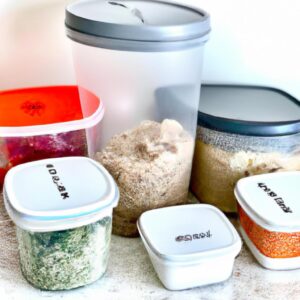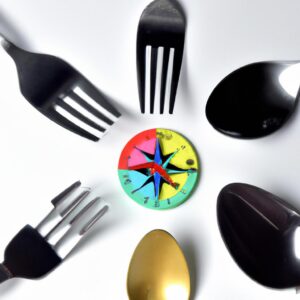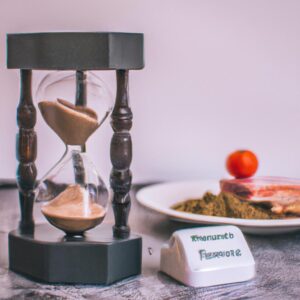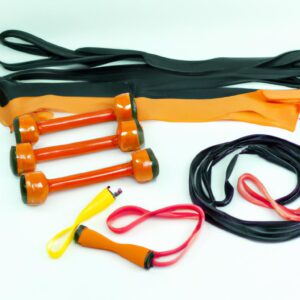Unlock Healthier Living w/Meal Prepping Tips & Strategies

Meal Prepping Tips for a Healthier Lifestyle
Meal prepping is a time-saving and cost-efficient way to enjoy healthy meals every day without spending too much time in the kitchen. Meal prepping helps you maintain a healthy lifestyle, while also allowing you to save on grocery bills, as well as wasted food. As an added benefit, it can also help reduce your chances of falling victim to unhealthy takeouts or convenience foods.
Meal prepping can be an overwhelming task at first, but with the right tips and strategies, you can make it a part of your weekly routine. Here’s a guide to help you learn the basics of meal prepping so you can lead a healthier lifestyle.
Make a Grocery List
Before you start meal prepping, it’s important to have a well-thought out grocery list. To save time and money, make a list of all the ingredients you need for the meals you plan on prepping. Keep a lookout for sales and discounts on fresh fruits and veggies to save even more. With a grocery list in hand, you won’t need to make multiple trips to the store or buy items that you don’t need.
Calculate Your Calories
When meal prepping, it’s important to know what your caloric needs are to ensure that you’re getting the right amount of nutrition. Start by calculating your daily recommended caloric intake using an online calculator, then use this number to determine the right portion sizes for your meals. A balanced meal should include lean proteins, complex carbohydrates, and healthy fats.
Choose Foods
When stocking up for meal prepping, try to incorporate a variety of healthful foods into your diet. Choose lean meats such as poultry, fish, and lean cuts of red meat to provide your body with complete proteins. Add plenty of fruits and veggies for vitamins and minerals, and whole grains like quinoa, bulgur, and oats for your carbohydrate needs. Don’t forget to include healthy fats like nuts, seeds, and avocados for satiety and essential fatty acids.
Make a Grocery List
Meal prepping can be a great way to save time and money when preparing meals. Before you start meal prepping, it’s important to make a grocery list of all the items you will need. This will help you stay organized and save you from making unnecessary trips to the store.
Instead of purchasing processed convenience foods or eating out, make sure you buy ingredients that are healthy and nutritious. This will help you create delicious, homemade meals that are ideal for meal prepping. Look for lean proteins such as chicken, fish, and eggs. Stock up on plenty of fruits and vegetables in addition to wholegrain carbohydrates like oats, brown rice, and quinoa.
By having a plan in place, you can avoid food waste and ensure that you have all the essential ingredients to create your meals. You’ll also be able to keep an eye on your spending and stick to your budget.
Calculating Your Calories
In order to maintain a healthy lifestyle, it’s important to know the amount of calories you need each day. A calorie calculator can help you do that. This tool takes into account your age, weight, height, and activity level in order to determine how many calories you need every day.
Once you have calculated the amount of calories your body needs, it’s time to talk portion sizes. The size of what you eat is just as important as what you eat. A good rule of thumb when preparing meals is to fill half of your plate with fruits and vegetables, one-quarter with lean proteins, and one-quarter with wholegrain carbohydrates.
Choose Foods for Meal Prepping
When it comes to meal prepping, choosing the right foods is a key step towards a healthier lifestyle. Some healthy options to stock up on when meal prepping include lean meats like chicken, fish, and turkey; plenty of fruits and vegetables; and wholegrains such as oats, quinoa, and brown rice.
Lean meats are an excellent source of proteins, B vitamins, and essential minerals like iron, zinc, and selenium. Fruits and vegetables are full of vitamins, minerals, and dietary fiber to keep you feeling full longer. Lastly, wholegrains are packed with more fiber, vitamins, and minerals than their processed counterparts, to provide energy and nutrients throughout the day.
Including these food groups in your meal prepping sessions will ensure that you’re getting the proper nutrition your body needs. Aim to have a variety of colors in your meals as an indicator of nutritional value, like dark green spinach, red tomatoes, and yellow peppers.
Meal Prep Strategies
Meal prepping is a great way to save time and money while creating delicious, nutritious meals. There are multiple strategies you can use to make meal prepping easier for yourself. Here are just a few:
- Cook in Bulk: Prepping meals in bulk is a great way to save time and money. Make a few different meals that you can rotate throughout the week for an easy and varied diet.
- Freezer Bags and Pre-Chopping: Pre-chopping your fruits and vegetables makes meal prep go faster. You can also freeze cooked meals to make it even easier. Adding ingredients to freezer bags helps make storing cooked meals easy and mess free.
- Utilizing Leftovers: Don’t let leftovers go to waste! Make sure to store them properly then warm up in the microwave when you’re ready to enjoy them again.
These tips can help make meal prepping easier and more efficient for busy lifestyles. Whether you’re new to meal prepping or a seasoned pro, there’s always something new to learn.
Meal Planning Ideas
You don’t have to get stuck in a boring meal prepping routine. Having a variety of meals in your plan can keep things interesting and make sure you’re getting balanced, nutrient-rich meals. Here are some ideas to help you create delicious meals for your meal prepping schedule:
- Make a big batch of stir-fry with a variety of veggies, lean meats, and brown rice.
- Try tacos with lettuce wraps instead of taco shells for a lighter option.
- Get creative with salads by adding fruits, nuts, and different dressings.
- Grill up chicken or salmon with roasted vegetables for an easy meal.
- Prepare breakfast bars with oats, dried fruit, and nuts.
- Beans on toast is a classic meal that’s inexpensive and filling.
- Mix lentils, quinoa, and veggies for a flavorful salad.
- Brush up on your pasta skills and prepare a tasty sauce to go with it.
- Throw together some quick, healthy snacks like muffins, energy balls, or trail mix.
There are plenty of recipes available online that are easy to follow and will help you stay on track with your meal prepping goals. Experiment with different types of ingredients and combinations, so you never get bored of the same old meals.
Meal Prep Tips for a Healthier Lifestyle
Meal prepping can be a great way to save time, money, and improve your overall health. To make your meal prepping journey easier and more successful, here are some tips that will help you do just that.
1. Use Mason Jars
Mason jars are the best way to store and transport your prepped meals. Not only are they airtight, but they come in different sizes which allows you to easily portion out your meals into specific servings. Furthermore, mason jars look great and can give your meals an extra bit of visual appeal.
2. Cook with Herbs and Spices
Adding herbs and spices to your meals can help make them more interesting and flavorful. They are also rich in nutrients that can improve your overall health. Consider buying a variety of herbs and spices to keep your meal prepping routine fresh and exciting.
3. Use Non-Stick Cookware
Non-stick cookware is indispensable when it comes to meal prepping. They are designed for easy cleanup and they also help prevent food from sticking to the pan during cooking. Plus, they often don’t require using oils, which can lead to unhealthy eating habits.
4. Pre-Chop Ingredients
Pre-chopping your ingredients can save you time when cooking. Consider chopping your vegetables ahead of time and storing them in mason jars or airtight containers for longer lasting freshness.
5. Utilize Leftovers
Don’t be afraid to take advantage of leftovers. Leftover cooked meats, grains, and vegetables can be used to create delicious new meals and can be great options to switch things up in your meal prepping routine.
With these tips in mind, you can now begin on your journey to healthier eating and a healthier lifestyle.
Storing Your Meals the Right Way
When it comes to meal prepping, it’s important to not only think about what meals you are prepping but also how to store your meals. Proper storage solutions are essential for keeping prepped meals fresh and safe for eating.
Here are some tips for storing your meals:
- Consider using containers with airtight lids, such as glass or plastic. These will keep food safe from contamination and keep air out that could lead to spoilage.
- Find containers or bags that are BPA-free and non-toxic. Certain plastics can contain dangerous chemicals that can leach into your food when exposed to heat.
- If you have fragile foods like fruits and vegetables, opt for sturdy glass storage containers that won’t break easily.
- Vacuum sealing is an option for preserving prepared meals for a longer period of time. This method kills all bacteria present on the food and greatly reduces the chances of food spoilage.
Taking the time to ensure that you’re storing your meals properly will give you peace of mind that the food is as safe and fresh as when you first prepped it. Additionally, it will help you to enjoy meal prepping and make it a more enjoyable experience.
Getting Started with Meal Prepping: Resources
For readers just getting started on their meal prepping journey, it’s helpful to have some resources to help them along the way. There are many websites, apps, and materials that can support meal prepping success.
One resource that can be helpful is a website or app dedicated to meal prepping. These tools can give readers access to ideas, recipes, grocery lists, and nutrition advice. They’ll also usually have step-by-step instructions to make meal prepping less daunting.
Another resource readers can use is cookbooks. These offer a wide variety of recipes that can both inspire and educate. They also feature vital information about proper storage, food safety, and nutrition.
Finally, YouTube videos and cooking shows can be a great source of inspiration for readers who want to learn more. Watching professional chefs do their craft can also help readers exponentially when it comes to making meals.
From websites and apps to cookbooks, shows, and videos, there are plenty of resources available to help readers get started on their journey.
Meal Prepping: How it Can Lead to a Healthier Lifestyle
With the right meal prepping plan, you can have your food prepared ahead of time so that you reach your health and wellness goals. Meal prepping allows you to save time during the week by having meals ready to go when it’s time to eat. This way, you don’t have to worry about what meal you’re going to make up and it allows you to stick to a healthier diet.
Meal prepping helps you to save both money and time as it eliminates impulsive stops at the grocery store or fast food eatery. You can actually plan out your meals in advance, buy all the ingredients at once, and cook for the entire week on one lazy Sunday afternoon. Meal prepping also helps with portion control; it is much easier to plan and measure out the proper amounts in advance.
By taking control of your nutrition, you will be able to eat healthier while feeling more energized and focused, which can lead to improved physical and mental health. When you create meals that are balanced in macro and micro-nutrients such as proteins, carbohydrates, and healthy fats, you will be providing your body with the best fuel it needs. Meal prepping is a great way to ensure that you stick to your healthy eating habits.
comments: 0






